
Weight Management
Managing your weight can be a challenge, but Crossover is here to help. From explaining the phases of weight management to covering all aspects of the tools available to you, including medications, diet, exercise, and mindset tricks, we’ve got you covered. Your team is ready to help you achieve and maintain your weight loss or weight management goals.
Explore this module for in-depth info and useful videos.
Stick with the most helpful habits and exercises.
Want more support? Start a conversation with your care team.

YOU’LL LEARN ABOUT:
- Crossover’s Approach to Weight Management
- Your Team
- The Phases of Weight Management
- Reasons You Might Want to Lose Weight (And a Few Reasons Why You Shouldn’t)
- Goal Setting
- The Physiology of Weight Loss—It’s Complicated!
- The Weight Management Toolbox
- Mindset Matters
- Medications
- Surgery
- Physical Activity for Weight Management
- Diet for Weight Management
- Addressing Your Stress
- Improve Your Sleep
- Celebrate Your Success
- Getting Back On Track
- How Crossover Can Help
Expert Guidance Along the Way
-
Brendon Rearick, CFSCFitness Program ManagerBrendon is the Fitness Program Manager at Crossover. His drive to be the best version of himself led him to co-found Certified Functional Strength Coach, a fitness education company to certify trainers, for which he travels and coaches for often. Brendon holds a degree in Kinesiology from the University of Massachusetts Amherst.
-
Colette Micko, MS, RDNHealth CoachColette believes that finding optimal health is key to living a happy life. She loves getting to know each and every patient, learning about their background and what motivates them, and working with them to reach their health goals.
-
Robert Pampin, DOAs his career has progressed, Robert has felt the need to help people understand that the role of primary prevention is critical. Further, it is far more important to prevent disease and reverse harmful trends, rather than wait and treat patients once it is well established.
Crossover’s approach to weight management was created by a group of health experts from different backgrounds. Our aim is to help you manage your weight and metabolic health using a mix of lifestyle changes, mental health tools, and medicine (if necessary) to achieve long-lasting results. We understand that weight management can be emotionally complicated, and that it can be related to other challenges in your life, such stress and eating disorders. We also understand that your weight is just one aspect of your overall health, and that you can make positive changes to your health without significant weight loss.
At Crossover, we want you to get well, be well, and stay well. When it comes to weight management, you get an entire care team to help you every step of the way. Your care team includes:
Primary care providers: To help you with your health and give advice on how to manage your weight. The providers at Crossover can help you with medicine if you need it, and make sure the medicine is right for you. They can also help you with other health problems that come from having too much weight.
Nurses: Working with the primary care providers, our nurses get important information about your health, like your weight, waist circumference, and blood tests. They’re also there to check on you and make sure you’re doing well during your weight management journey.
Health coaches: To help you use what you know about weight loss and give guidance on healthy eating, exercise, sleep, stress, and smoking. Some health coaches at Crossover are also registered dietitians who can give specific advice about eating plans. Because there is not a one size fits all solution, you can work together with your health coach to make a plan that is realistic and sustainable so that you can be sure to succeed.
Fitness coaches: No matter where you are in your weight management journey, our fitness coaches offers something for everyone. During this check, we give advice that will help you reach your goals in the best way for you. This might depend on your lifestyle, goals, and financial situation. Remember, there are many ways to exercise that don’t need a gym. Plus, the first fitness assessment and our online fitness classes are free!
Mental health therapists: Our therapists can help with things like feeling anxious, sad, or having a hard time with your weight loss journey because of past experiences. They can also help you with things like binge eating and how you feel about yourself overall.
Physical medicine providers*: Get help with starting an exercise program and sticking to it, with activities that you enjoy. We can also help you get past your worries about how your body will react to exercise or any pain that might be limiting your ability to move. Work with providers in person or virtually, and get advice on how to do exercises the right way, so you can thrive.
*Physical medicine is not available to all members. Check with your employer or benefits team to see if you have access to this service.
Losing weight in a healthy and sustainable way happens in phases, over time. These phases include:
Assessment: First, your healthcare provider will evaluate your current health status, medical history, lifestyle habits, and weight loss goals. They’ll also screen you for any issues with disordered eating, or other mental health challenges that could affect your weight. They will use this information to create a personalized plan that fits your specific needs.
Weight Loss: During this phase, you’ll use different tools, such as making changes to your diet and exercise routine or maybe including a weight loss medication, to help you lose weight.
Weight Stabilization: Once you have reached your goal weight, the next phase involves maintaining that weight for the future. This may involve ongoing monitoring, support, and adjustments to your plan as needed.
Maintenance: The final phase involves continuing the healthy habits and behaviors you learned during the weight loss and stabilization phases to maintain a healthy weight long term. This may involve ongoing support and follow-up with healthcare professionals, as well as continued lifestyle changes to prevent weight gain.
There are many reasons why you might be considering losing weight. Here are a few good reasons to lose weight:
- Weight is making some of your other health conditions harder to manage.
- Weight is affecting your mobility and ability to move in the ways you wish.
And here are some not so good reasons to lose weight. Consider if any of these apply to you:
- Appearance-based reasons: Losing weight solely to achieve a certain body type or to look like someone else can lead to body image issues and a negative relationship with food and exercise.
- Pressure from others: Feeling pressure from friends, family, society, and even your healthcare provider to lose weight can lead to unhealthy behaviors and a negative self-image.
- Unrealistic expectations: Setting unrealistic weight loss goals or expecting immediate results can be discouraging and lead to giving up or engaging in unhealthy weight loss practices.
- Comparison to others: Comparing yourself to others and feeling like you need to lose weight to measure up can lead to negative self-talk and body dissatisfaction.
- Weight loss might make your health worse: If you’re pregnant, have struggled with an eating disorder in the past, are undergoing treatment for cancer, or are experiencing a health condition that is unstable or untreated, losing weight is not advisable and could be dangerous.
Ultimately, the choice to lose weight is yours. At Crossover, we want to make sure you’re feeling confident in your choice, and are engaging in behaviors and practices that support your best health.
Research suggests that losing just 5-10% of one’s initial body weight can result in significant health benefits, such as improved blood pressure, blood sugar control, and cholesterol levels. For example, someone who weighs 200 pounds and loses 10-20 pounds can experience health improvements. However, it’s important to note that the amount of weight loss needed to achieve health benefits can vary depending on the individual’s starting weight, body composition, and overall health status. Additionally, it’s important to know that even modest weight loss can be difficult to achieve and maintain, so it’s important to focus on healthy behaviors rather than just a specific number on the scale.
That’s why it’s also important to think about goals around sustainable lifestyle behaviors. The ways you choose to move your body and adjust your diet need to be things you can stick with for the long term.
Here are some examples of goals you might consider during the active weight loss phase:
- Lose at least 5 to 10 percent of your starting weight.
- Work up to least 150 minutes of physical activity each week.
- Improve your metabolic markers (Blood Pressure, Hemoglobin A1c, Lipids/Cholesterol, or Glucose).
- Improve the quality of your diet to include more nutrient-rich foods (fruits, vegetables, whole grains, lean proteins, plant fats).
- Eat fewer foods high in empty calories, fats and sugar.
Here are some examples of goals you might consider when you’re trying to maintain your weight:
- Maintain lost weight with +/- 5 lbs
- Keep getting at least 150 minutes of activity each week or increase by 10 minutes each week
- Continue to eat a diet high in nutrient-dense foods and low in excess calories, fat, and sugar
- Maintain or further improve your metabolic markers (Blood Pressure, Hemoglobin A1c, Lipids/Cholesterol, or Glucose)
Creating an Action Plan
You may have heard that goals without a plan are just dreams. Think about what actions you need to put in place to achieve your goals. Use this as a guide:
- Be realistic. Plan actions that are realistic for you.
- Make it doable. Plan small changes. Over time, these changes will add up.
- Be specific. Plan your actions in detail. Decide:
- What you will do
- Where you will do it
- When you will do it
- How long you will do it
- Be flexible. Review your action plan often.
- Look for ways to cope with challenges. If your action plan isn’t working for you, revise it.
- Focus on behaviors. For instance, you cannot directly control how many pounds you lose, but you can control your actions, such as what you eat and how active you are.
- Make it enjoyable. Change doesn’t have to be painful. It can be fun! So find activities and healthy foods that you enjoy.
Practice setting an action plan with the attached handout.
Understanding Calorie Surplus and Calorie Deficit
When you eat or drink something, your body breaks it down into nutrients like carbohydrates, proteins, and fats, which are used to fuel your body’s functions. Your body needs a certain amount of calories from food and drinks each day to maintain your weight. If you consume more calories than your body needs, the excess calories are stored in fat cells, leading to weight gain.
Weight loss happens when you consume fewer calories than your body needs, forcing it to use stored fat for energy. This is called a calorie deficit. When you create this calorie deficit through a combination of healthy eating and exercise, your body begins to break down stored fat into energy, resulting in weight loss.
The Role of Genetics and Hormones
Unfortunately, if you thought that weight loss was simply a math equation (eat fewer calories than you burn), the truth is it’s not that simple. Genetics and hormones play a role in how your body processes food and stores fat, which can affect weight loss. Some people have a genetic predisposition to store fat more easily or to have a slower metabolism, which can make it harder for them to lose weight.
Hormones like insulin also affect weight loss. Insulin helps our bodies use glucose for energy, but when we eat too many carbohydrates, our bodies produce too much insulin, which can lead to weight gain. Leptin is a hormone that helps regulate our appetite and metabolism (it tells us when we’re full). When we become overweight or obese, our bodies can become resistant to leptin, which can make it harder to lose weight. Additionally, as you lose weight, leptin levels drop and, like a fuel gauge, the body increases appetite. It can also drive you to become less active.
Ghrelin is a hormone that makes you feel hungry. When you haven’t eaten in a while, your body releases ghrelin to tell your brain that it’s time to eat. The problem is that when you try to lose weight by eating less, your body might release more ghrelin to try to get you to eat more. This can make it harder to stick to a diet and lose weight. Additionally, when you lose weight, your body may produce more ghrelin to try to get you to eat more and regain the weight you lost. This can make it difficult to keep the weight off once you’ve lost it. You can work with your care team to develop strategies to address the “ghrelin grumble” if it’s something you experience.
Set Point Theory
Set point theory suggests that the body has a built-in mechanism to maintain a certain weight range, known as the “set point.” This means that even when you try to lose weight, your body may resist by increasing hunger and decreasing metabolism in order to bring you back to your original weight. The theory suggests that genetics, hormones, and other factors can influence your body’s set point, making it harder or easier to lose weight.
While the information above can feel a bit overwhelming and maybe even a little disappointing or discouraging, it’s important to understand that because weight management is so complicated, there isn’t always a simple, straightforward solution. It may require different types of tools to be successful. The good news is that because there are more tools than ever before, you and your care team can choose which tools are right for you, so that you can achieve your weight loss and maintenance goals.
In the next several sections, we’re going to start talking about tools that you can use to assist your weight management journey. They include:
- Mindset
- Physical activity
- Nutrition
- Sleep
- Stress management
- Medications
- Surgery
- Maintenance techniques
Keep in mind that a lot of different factors will determine which tools are available to you or appropriate for you. Use the information in this section to have a discussion with your care team, based on your unique situation.
Now that you have considered your goals and an action plan, let’s talk about mindset. As you already know, changing your habits can be easier said than done. Oftentimes, your mindset can hold you back from making the changes you want to see for yourself. However, being prepared for the ways your mind will fight against you can make all the difference for your success.
Change is Hard
This is the point in the process where it’s important to acknowledge that change is hard, especially changes to your lifestyle. We know that you might have very good reasons for changing and also, at the same time, very good reasons for staying the same. This is known as ambivalence and it’s perfectly normal. One way to break free from ambivalence is to make the advantages of change outweigh the disadvantages. Check out this worksheet and video to learn how to do just that.
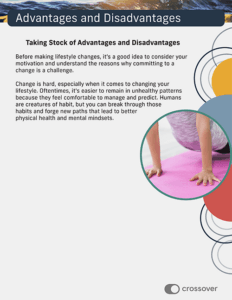 Advantages and Disadvantages of Change
Advantages and Disadvantages of Change
Dealing with Negative Thoughts
Sometimes, negative and unhelpful thoughts can drag you down and cause you to act in ways that go against your goals. The handout and video below can help you counter negative thoughts as they come up.
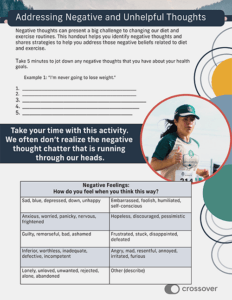 Addressing Negative and Unhelfpul Thoughts
Addressing Negative and Unhelfpul Thoughts
Dealing with Tempting Thoughts
In addition to negative thoughts, tempting thoughts seem to be around every corner, waiting to trip you up or keep you stuck in your same old routine. Use the worksheet below to identify and reframe your tempting thoughts.
Getting Support
One of the biggest challenges to making lifestyle changes can be getting support from the people around you. Friends, family, and coworkers mean well, but sometimes they can’t or won’t support you in your goals. The handout below can help you get support from the people around you.
Exercise has many benefits that go beyond weight loss, including:
- Better sleep and mood
- Improved balance and flexibility
- Lower risk of heart attack and stroke
- Lower stress levels
- Increased energy
- Stronger muscles
- Improved body composition
When it comes to weight loss, nutrition and other lifestyle factors have a bigger impact than exercise. You must be in a calorie deficit to lose weight. This means you need to burn more calories than you consume. Decreasing your calorie intake is usually easier than trying to burn off extra calories you’ve consumed.
However, while exercise might not be great for losing weight, it’s the best way to maintain a healthy weight.
Exercise has two main functions for weight loss:
- Research has shown that 70% of those who are able to maintain a healthy weight for up to three years after a weight loss program engage in regular physical exercise.
- Exercise helps regulate your satiety signals, or the feelings of being full and satisfied after eating. When you exercise regularly, you are more likely to consume only the amount of calories your body needs to refuel. When you are sedentary and don’t get enough physical activity, these satiety signals are suppressed, or harder to notice.
How Much Activity Do I Need?
It is recommended that you work up to at least 150 minutes of moderate physical activity or 75 minutes of vigorous physical activity each week. This should include at least two days of muscle strengthening activity, and should also include flexibility exercises. Sound overwhelming? It doesn’t have to be. Head over to our Exercise Basics page to learn more.
Safety
When adding exercise to your daily routine, safety comes first. Use the checklist below to help you avoid injuries or flare-ups of any preexisting conditions. If you check any of the boxes, talk to your doctor before getting started with your new activity.
□ I’m over 50 and I haven’t been active in a long time. I’m now planning to be very active.
□ I’m pregnant. My healthcare provider hasn’t given me the OK to start exercising.
□ I become very winded or short of breath with slight activity.
□ I have a health problem or other issue not listed here that might need attention if I start exercising or increasing my daily activity level.
□ I have a heart problem. My healthcare provider wants to keep an eye on my activity level.
□ I have bone or joint problems that make it hard for me to do things such as walking quickly.
□ I have chest pain that started within the last month.
□ I tend to pass out or fall down when I get dizzy.
□ During or right after a workout, I often have pain or pressure in my neck, left shoulder, or arm.
□ My healthcare provider wants me to take medicine for high blood pressure or a heart problem.
Here’s a handout of the checklist you can bring with you to your doctor:
If you didn’t check any boxes on the list above, or you were cleared by your doctor to begin an exercise regimen or increase your daily activity, now it’s time to think about what else you might need to exercise safely. This could include:
- Dressing for the activity: Wear the right shoes and clothes and use safety gear as needed.
- Hydrate: Drink water before, during, and after your workout or activity, even if you don’t feel thirsty.
- Listen to your body: Slow down or stop if you feel very tired, sick, faint, or your joints hurt.
- Mix it up: Do a variety of activities to avoid straining any one part of your body.
- Start small: If you train too hard or too often, you may get hurt. Aim to make slow, steady progress over time.
- Warm up before you work out and cool down after. Take five to 10 minutes for each.
- Watch out. Be careful not to trip or bump into anything.
- Work with the weather: Exercise indoors if it’s too hot or too cold. If you become overheated, you may get a headache, a fast heartbeat, or you may feel dizzy, sick to your stomach, or faint.
- Using good form when strength training.
Head over to our Strength Training page to learn more.
Getting Started
For some, getting started is the biggest challenge. When thinking about starting an exercise routine or increasing your activity levels, it can help to ask yourself these questions:
- What type of activity do you enjoy doing?
- What has worked for you in the past?
- What time of day might be best for you to exercise?
- When in the day is your energy highest?
One of the most important things to remember is that you want to make slow, steady progress. Don’t try to change everything at once, and don’t try to run five miles on your first try. Remember that you can increase your physical activity without spending hours in a gym, and that there are so many great ways to get active. Here are a few suggestions to get you started:
- Set an alarm to get up and walk the perimeter of your office building every hour.
- Dance to your favorite music.
- Pace the sidelines at your children’s or grandchildren’s sporting events.
- Play actively with your children or pets.
- Walk to the local farmer’s market.
- Run, bike, or walk quickly when doing errands.
- Start a new active hobby, such as biking or hiking.
- Take a walk after dinner with your family or by yourself.
- Take a walk with a coworker or by yourself during your lunch break.
- Plan walking meetings.
- Track your steps with a pedometer. Work up to 10,000 steps or more per day.
- Walk around whenever you talk on the phone or are on a conference call.
- Walk briskly when you shop.
- Walk up and down escalators instead of just riding them.
- Go to the bathroom, breakroom, or micro-kitchen on a different floor in your office building.
- Walk your dog each day.
- When you watch TV, stand up and move or do chores during the commercials.
- Take the stairs whenever possible.
- Get off the bus, train, or subway a few stops before your destination and walk the rest of the way.
If walking isn’t possible or comfortable for you, here are a few ideas to try:
- Strength training
- Water aerobics
- Chair dancing
- Chair yoga
- Stretching
- Biking
- Rowing
NEAT
Moving more means increasing your non exercise activity time! Did you know, you can burn hundreds of calories each day without adding additional time at the gym? Non-exercise activity thermogenesis (NEAT) is the name for any activity that burns calories outside of purposeful exercise. Incorporating small, quick changes to your normal routine can have a big effect on your metabolic health. Think about how you can fit more movement (no matter how small) into your life.
Here are a few examples that you can use to increase your NEAT depending on where you’re starting:
- Increasing step count throughout your day
- Adjust your environment to make the tasks you need to do more easy to complete (set out workout clothes night before, use a standing desk half the day, or hide unhealthy foods)
- Increasing your water intake
- Improve your nightly sleep hygiene to get better quality sleep
- Plan your meals each week
- Keep healthy snacks readily available
- Hire a fitness coach and set up a plan
- Encourage a friend to workout with you on the days that are most challenging for you
Exercise Selection
Cardio for weight loss – the media would lead you to believe that cardio is the best form of exercise to lose weight. Cardio does help burn calories but so do strength training and better nutrition choices.
For more information on Cardiovascular training, take a look at our Cardio Basics Page.
Strength training for weight loss – when it comes to strength training for weight loss, it can be simply stated the more muscle you have the more calories you’ll burn throughout the day. Additional benefits of strength training include less prone to injury, increased bone density, being more self sufficient, and aging well.
For more information on Strength Training, take a look at our Strength Training Basics Page.
Circuit training for weight loss – circuit training is a great tool for weight loss because it enables you to work different movement patterns and muscles while continuously moving. Your rest time in circuit training can be utilized while doing the next exercise in the circuit which requires completely different muscles than the other exercises involve.
Here is an example of full body circuit:
- Lower body: Goblet squats x 12 reps
- Upper body: Bent over dumbbell row x 8 reps on each arm
- Core: Plank for 30 seconds
- Metabolic: Tall Plank Mountain Climbers x 30 seconds
- Stretch: Downward Dog x 30 seconds
Do as many rounds as you can in 20 minutes. Resting as needed. Record the weights you used and how many rounds you did. You’ll know you’re improving if you can get in more rounds in the allotted time or if you can do that same amount of rounds but with heavier weights. For more information about creating your own routines and workouts, take a look at our Exercise Basics Page.
Fitting in Fitness
With all of life’s demands, fitting in daily activity can feel impossible. The handout below can help you find the time, even if you have a desk job.
Making Activity a Habit
It can be challenging to stay active. It’s important to remember the reasons why you’ve decided to make a lifestyle change, in order to stay motivated and excited to continue your journey. Here are some common challenges you might face and ways to cope with them:
| Challenge | Ways to Cope |
| I have less time for exercise due to life changes. |
|
| I have less money due to life changes. |
|
| The weather is making it hard to walk outdoors. |
|
| I’m injured. |
|
Many factors (or cues) in your environment can lead you to being inactive. For example, after dinner, you may automatically sit down in front of the TV. Remember that every day, you have a choice to do something different. You could choose to take a walk after dinner instead of watching TV. To become active regularly, you must add positive activity cues into your life. Over time, the cues will help to create a regular pattern of activity.
Take a look at the handout below for more information on building positive activity cues.
Finally, think about getting help. Crossover has fitness trainers who can help you start your movement journey safely. They even offer FREE fitness assessments and fitness classes. Visit the Fitness page to learn more and sign up.
Once you have established a habit around exercise, you can begin to level up your practice for even more benefit. Check out the resources below for tips on how to stay active even when you’re away from home and how to incorporate strength training into your fitness routine.
Movement Away From Home
Being active away from home (and away from your routine) can be challenging. Here are a few resources that can help you maintain your activity level, no matter where you are.
Eating well is an important part of improving your health and reaching your health and weight goals, but it can often feel overwhelming and confusing at first. In this section, you’ll learn the building blocks of healthy meals and snacks.
Calories
Calories are a unit of energy. Everything you eat or drink (except water) contains calories. Your body is constantly burning calories, even when you’re at rest. The more activity you do, the more calories you burn. The handout below will help you determine how many calories you should be consuming per day.
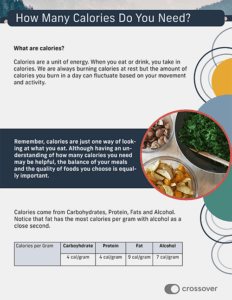 How Many Calories Do You Need?
How Many Calories Do You Need?
You can also use this calculator to figure out your calorie needs: https://www.niddk.nih.gov/bwp
Macronutrients
Macronutrients are the building blocks of everything you eat or drink. The three macronutrients that make up most of what you consume are: carbohydrates, proteins, and fats. Having a balance of macronutrients in your diet helps contribute to whole-body health. Take a look at the handouts below to learn more about macronutrients.
Putting It Together
While it’s helpful to know about calories and macronutrients, it’s not practical to think of your meals in these terms. Use the handouts below for tips on how to build healthy meals and snacks.
Diets for Weight loss
There is not just one right way to eat for weight loss. The most important thing is to find a plan that works for you. Take a look at the handout below for descriptions of different weight loss diets and their pros and cons.
Tracking
Tracking calories, macronutrients, or meals can be a helpful tool to see patterns in your eating habits, and to give you clues on where you might be consuming too much or not enough. Also, in order to track, it’s helpful to have information about labels and serving sizes. Take a look at the handouts and videos below for tips on tracking, food labels, and serving sizes.
![]() How To Cope with Challenges – Tracking Food
How To Cope with Challenges – Tracking Food
 Everyday Objects as Serving Sizes
Everyday Objects as Serving Sizes
Now that you’ve covered the basics of nutrition, you’re ready to learn even more useful tools.
Meal Planning
Meal planning can be a game-changer for your goals. The handouts below will teach the basics of meal planning, cooking, and shopping. If you need some help, our health coaches at Crossover are available to make these tools work for you.
 Basic Meal Planning Guidelines
Basic Meal Planning Guidelines
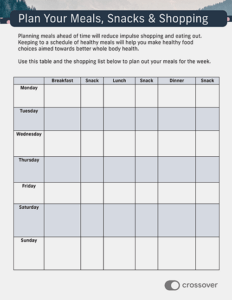 Plan Your Own Meals and Snacks + My Shopping List
Plan Your Own Meals and Snacks + My Shopping List
The resources below are full of valuable information on shopping and cooking.
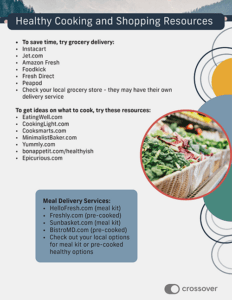 Healthy Cooking and Shopping Resources
Healthy Cooking and Shopping Resources
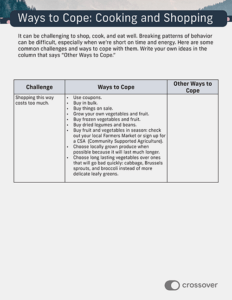 Ways to Cope – Cooking and Shopping
Ways to Cope – Cooking and Shopping
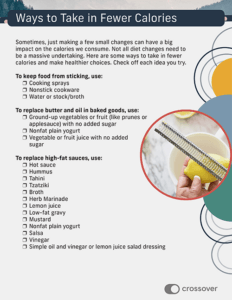 Ways to Take In Fewer Calories
Ways to Take In Fewer Calories
Food Cues
Have you ever thought about WHY you eat? The factors that affect what, when, and how much you eat are called food cues, and they can be positive or negative. Positive food cues lead to choices that are more in line with your goals. Negative food cues can lead you to eating too much, eating late at night or between meals, or eating foods that you don’t really want or even enjoy. Read the handout below for more information on food cues.
Eating Away from Home
While preparing food at home can often make it easier to stick to your goals, eating out is often necessary and, in our opinion, fun! Eating out can definitely be part of your life, even while you’re working on your health goals. Take a look at the handouts below for more information.
Beverages
We’ve talked a lot about what you eat, but what about drinks? Drinks can be a source of added sugar and calories without providing helpful nutrients such as vitamins, minerals, or fiber. So, choosing your beverages carefully can be an easy way to work toward your health goals. The handouts below will help you make the best drink choices.
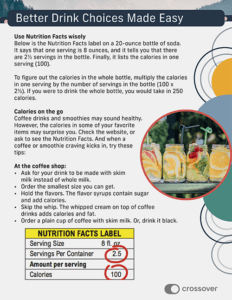 Better Drink Choices Made Easy
Better Drink Choices Made Easy
Now that you’ve learned the what, why, and how of eating, let’s talk about a way of eating that helps you put it all together. Mindful eating allows you to slow down and think about why you are choosing to eat, what’s going on around and within you, and helps you be fully involved in the process of eating. Check out the videos and handouts below to learn more.
The Realities of Stress and Eating
Do you eat when you’re stressed?
Everyone responds to and manages stress differently. About 40% of people report they eat more when they feel stressed. Around 40% eat less and 20% don’t change their eating during stressful times. Those who tend to eat when stressed often feel that stress-eating is a major health concern. It’s easy to blame it on having no willpower or on a lack of self-control. But considering what happens inside the body during stress, it seems less and less likely that your willpower is to blame. The body’s response to stress triggers the urge to eat. Understanding what happens in your body when you’re stressed can help you manage it.
Stress and appetite
Stress prompts the ‘fight or flight’ response in your body. When you experience stress, adrenaline (epinephrine) and cortisol (the stress hormone) are released. During the ‘fight or flight’ response, your body looks for sugar in your system in case you need to fight, or flee. In response, stored energy increases the sugar level in your bloodstream. Usually a hormone called insulin helps the sugar enter our cells to be used for fuel. But in stressful situations, your body stops insulin from working. That keeps the sugar levels higher, but it also means you have more insulin in your blood. If you’re stressed for a short time, your hormones will usually go back to normal. But when you’re under constant stress, your hormones stay at a higher level. After a while, this pushback against insulin gets worse. Insulin increases your appetite—and stress makes sugar, salt, and fat more appealing. Unfortunately, stress also decreases the reward signaling in the brain, as well as its sensitivity. All of these factors lead us to eating more of these types of foods than we normally would.
What happens to your eating and your body when you have a lot of stress:
Stress makes your body release a hormone called cortisol. Raised levels of cortisol may:
- Make blood sugars harder to control
- Cause weight gain, especially in the abdomen (visceral fat)
- Impact appetite and cravings
- Weaken the immune system
- Impact digestion
- Lead to heart disease
- Lead to fertility issues
The amount of cortisol that is released will be different in your body than in another person. That can help explain why stress makes some people eat more than others. Making yourself feel bad for eating when you are stressed leads to more stress! Food might make you feel better in the moment, but it can leave you feeling tired and guilty about what or how much you ate.
Stress can impact what you want to eat, how much you eat, and how that food is handled in your body. But when you’re stressed, weight gain isn’t just about food. People who are stressed often exercise less, sleep worse, and are more likely to turn to alcohol or other substances for some relief. That’s why it’s important to manage stress in healthy ways.
What to do about stress eating
Stress eating is a reality for many. But when eating becomes the only thing that makes you feel better, it’s a more serious issue. You need more than one tool in your toolbox. Finding new ways to manage both short-term and long-term stress can go a long way in improving your relationship with food and stress. Visit the section on stress on our Be Well website to learn more.
Managing Stress Eating with a Nourishment Menu
When you feel emotional or stressed, sometimes you might want to eat something even if you’re not really hungry. But before you grab a snack, try doing something else that makes you feel good, like a “nourishment activity”.
A nourishment activity is something that helps you feel better without eating. You can put different things on your nourishment menu, like things that make you happy or relaxed. The best part is, these activities don’t take long, usually just 1 to 5 minutes, and you can do them almost anywhere. Here are some ideas:
- Drink a tall glass of water
- Go on a short, brisk walk
- Go outdoors and scan the horizon
- Listen to an uplifting song or podcast
- Pet something cute and furry
- Call or text a friend
- Eat a piece of fruit or a raw vegetable
- Take 5 deep breaths
- Dance around the room to an upbeat song
- Organize a small area of your room, car, or desk
- Do some quick stretches
- Take a 5 minute cat nap
- Take a hot shower
- Plan out your next healthy meal or snack
- Read a good book
- Do a Sudoku or word puzzle (consider buying a book of puzzles instead of using an app on your phone)
- Journal about 3 things you’re grateful for
- Draw, sketch, or color in a (grown-up) coloring book
- Play an instrument you enjoy
- Pray or meditate
Keep your nourishment menu with you so you can use it whenever you need it. And try to pick things that are good for your health and make you feel good in a non-food way!
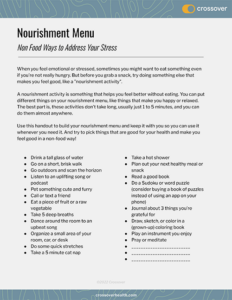 Coping with Stress Eating – Nourishment Menu
Coping with Stress Eating – Nourishment Menu
Mindful Eating: A Different Approach
The table below explains the principles of mindful eating. Pick a principle you’d like to try and give it a shot at your next meal. Remember, you don’t have to do all of these at once, or at every meal. Start slowly and see what works. For more information on each of the principles, check out the resources below the table.
| Raise Your Awareness | Practice tip: Before eating, check in with yourself. How hungry are you? Are you thirsty? What are you feeling? When you eat, use a plate so you can truly see how much you’re serving yourself. |
| Reduce Distractions | Practice tip: Turn off all screens, put away all work and reading, and sit at a table or counter. |
| Look at What You’re Eating | Practice tip: Does the portion you’re taking match your hunger? Are you eating a variety of foods? Try using a smaller plate or bowl to help control your portion size. At a restaurant ask them to pack half of your meal to go when you order. You might realize you’re satisfied with less. |
| Eat More Slowly | Practice tip: Put your fork down between each bite. Drink water between bites. And chew your food thoroughly. Try to spend 20-30 minutes eating each meal. |
| Enjoy Your Meal | Practice tip: Make the environment pleasant and use your senses to enjoy the meal. Look at your food, smell it, and notice how it tastes. |
Resources for “Raise Your Awareness” principle:

Resources for “Reduce Distractions” principle
Resource for “Look At What You’re Eating” principle
Resources for “Eat More Slowly” principle
Resources for “Enjoy Your Meal” principle
Stress can have a strong influence on your overall health. Stress can make managing your blood sugar more difficult, interfere with your sleep, drain your energy levels, and increase your hunger and cravings. In this section, you’ll learn how to recognize and manage stress. To begin, use the handout below to identify the causes of stress in your life.
Once you’ve identified where your stress is coming from, you can start to develop ways to cope with it. The resources below can help you identify coping strategies.
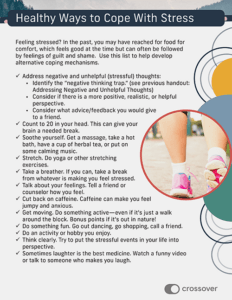 Healthy Ways to Cope With Stress
Healthy Ways to Cope With Stress
Stress can be difficult to manage at times. For a deeper dive on this subject, check out the Stress and Resilience page. Also, consider making an appointment with a Crossover mental health therapist if your stress feels like too much to manage on your own as they can be part of your weight management team.
What does sleep have to do with your metabolic health? As it turns out, quite a bit! The resources below will help you discover why sleep matters and how to improve yours.
Now that you understand why sleep is important, the next step is to work on getting enough good-quality sleep. Take a look at the resources below for improving your sleep quantity and quality.
Because your ability to lose weight can often be complicated by hormones and genetics, medications can be a useful tool to assist you, if necessary. Generally, medication is recommended if you are not successful in losing weight after three months of practicing guided lifestyle changes. Medications aren’t a replacement for lifestyle changes, but they can sometimes make those changes easier to stick with or make them work better. Up to 40% of weight lost with medication can be muscle mass, so it is critical to regularly exercise and maintain protein intake to avoid this, if medication treatment is sought. There are several types of weight loss medications:
Incretins (GLP-1 Agonists or GLP-1/GIP Agonists)
GLP-1 agonists, like semaglutide (Wegovy for weight, Ozempic for diabetes), are a type of medication that can help people lose weight. GLP-1 is a hormone that is naturally produced in the body, and it helps regulate appetite and food intake. GLP-1 agonists work by mimicking the effects of this hormone, which slows down the digestion of food and can help you feel full for longer periods of time. This can lead to eating less food overall, which can result in weight loss.
GLP-1 agonists can also help regulate blood sugar levels, which is especially helpful for people with type 2 diabetes. This is because they stimulate the pancreas to produce more insulin, which helps control blood sugar levels. Even in those without diabetes, the medication causes the body to release a smaller amount of insulin during eating than it normally would, which decreases fat storage.
As with any medication, GLP-1 agonists can have side effects, such as nausea, vomiting, diarrhea, low energy, hair loss. However, many people tolerate them well and find them to be a helpful tool in their weight loss journey. If you are prescribed this medication, your provider will want you to eat more slowly (over a period of 20–30 minutes), and eat smaller amounts of food to avoid side effects like nausea. It’s important to talk to your doctor about whether GLP-1 agonists are a good option for you and to discuss any potential side effects or concerns. It’s also important to note that GLP-1 agonists are new for treating weight loss and insurance coverage may vary.
Terzepatide (Zepbound for weight or Mounjauro for diabetes) works on two hormone systems, GLP-1 and GIP. This combination may yield greater weight loss. Side effects are similar to GLP-1 agonists, GI upset.
Combination Medications
Qysmia and Contrave are two medications that are approved by the U.S. Food and Drug Administration (FDA) for weight loss.
Qysmia is a combination of two drugs called phentermine and topiramate. Phentermine is an appetite suppressant that makes you feel less hungry, while topiramate is a medication used to treat seizures and migraines that can also help you feel full. By working together, these medications can help you eat less and feel satisfied with smaller amounts of food.
Contrave is a combination of two drugs called bupropion and naltrexone. Bupropion is an antidepressant that can also reduce your appetite and cravings, while naltrexone is a medication that is used to treat addiction to drugs or alcohol. By working together, these medications can help you eat less, reduce your cravings for unhealthy foods, and feel more satisfied with smaller portions.
Stimulants
Phentermine and phendimetrazine are two stimulants that are used for weight loss. Phentermine can help suppress appetite and increase metabolism. It’s often used as a short-term treatment, in combination with diet and exercise. Phendimetrazine is also usually prescribed for short-term use (a few weeks to a few months) as part of a weight loss program that includes a low-calorie diet and exercise. It is not a substitute for a healthy lifestyle, and it should not be used by people who only want to lose a few pounds.
Like all medications, phentermine and phendimetrazine can cause side effects, including nausea, headache, insomnia, dry mouth, and constipation. In rare cases, it can also cause more serious side effects such as high blood pressure, heart palpitations, and mood changes.
Surgery for weight loss is sometimes an option if other weight loss methods have not been successful or are not appropriate for you. One option is called gastric bypass surgery, which involves making changes to the stomach and small intestine to reduce the amount of food that can be eaten and absorbed. This surgery can lead to significant weight loss, but it also involves significant lifestyle changes and carries risks, like any surgery.
Another option is sleeve gastrectomy, which involves removing part of the stomach to reduce its size and limit the amount of food that can be eaten at one time. This can also lead to significant weight loss and is similar to gastric bypass surgery in terms of risks and required lifestyle changes.
Finally, a laparoscopic adjustable gastric banding procedure involves placing a band around the top of the stomach to create a smaller pouch, which can help control the amount of food that can be eaten at one time. This procedure is less invasive than the other two and the band can be removed if necessary, but it may not be as effective in achieving significant weight loss.
Celebrating your success can help you stay motivated. It’s important to mark the ways your life has changed for the better, especially when reaching a goal. Take a look at the resource below for some healthy ways to celebrate.
Maintaining our health and weight is not always a straightforward path. Like with many things in life, sometimes it feels like we take two steps forward only to take one or several steps back. This is normal! Changing habits is hard, and you can expect to get thrown off track at times. The handouts below can help you accept setbacks, cope with challenges, and move forward in the pursuit of your goals.
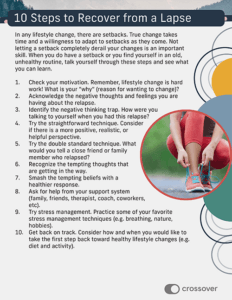 10 Steps to Recover From a Relapse
10 Steps to Recover From a Relapse
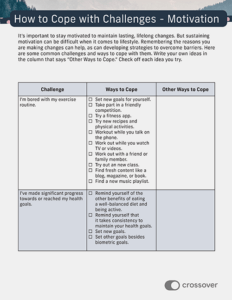 How to Cope With Challenges – Motivation
How to Cope With Challenges – Motivation
If you are attempting to lose weight and your progress stalls, that can be particularly demotivating. The handout below can help you cope with stalls and get through them successfully.
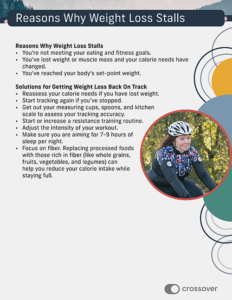 Reasons Why Weight Loss Stalls and Solutions to Get Back on Track
Reasons Why Weight Loss Stalls and Solutions to Get Back on Track
Your Crossover care team is here to help. We have coaches who can make a plan so you know where to start. Our mental health team can talk you through your stress and anxiety. Our physical therapy team can help you recover from injury with safe movement. Or you can start with a physical for a full picture of your overall health. Wherever and whenever you’re ready to begin, just connect with your Crossover care team. We want you to be well.
Some of the resources you see on this page come from or were adapted from the CDC’s Diabetes Prevention Program. To learn more, visit the National Diabetes Prevention Program Website.

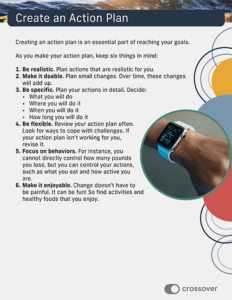 Creating an Action Plan
Creating an Action Plan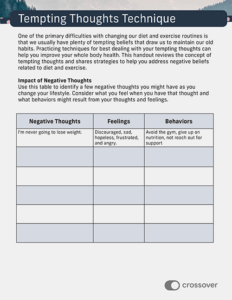 Tempting Thought Technique
Tempting Thought Technique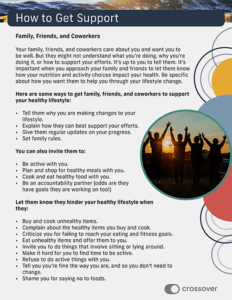 How to Get Support
How to Get Support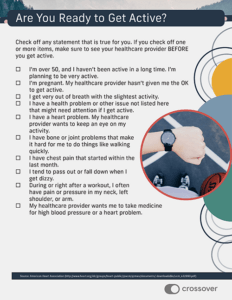 Are You Ready To Get Active
Are You Ready To Get Active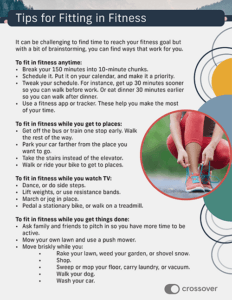 Fitting In Fitness
Fitting In Fitness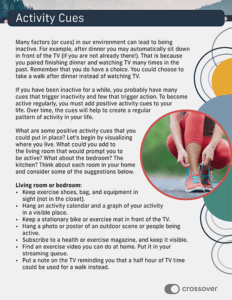 Activity Cues
Activity Cues Ways to Cope: Getting Active Away from Home
Ways to Cope: Getting Active Away from Home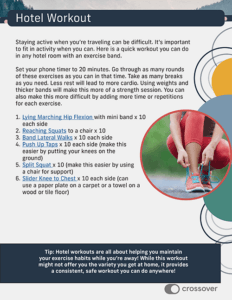 Hotel Workout
Hotel Workout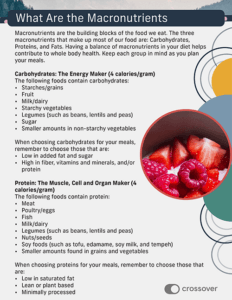 What are the Macronutrients?
What are the Macronutrients? All About Fats
All About Fats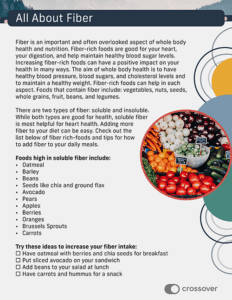 All About Fiber
All About Fiber Carbs by the Number
Carbs by the Number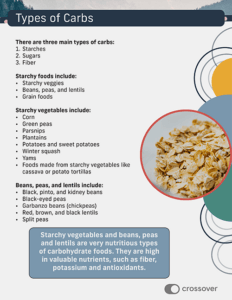 Types of Carbs
Types of Carbs A Healthy Approach to Carbs
A Healthy Approach to Carbs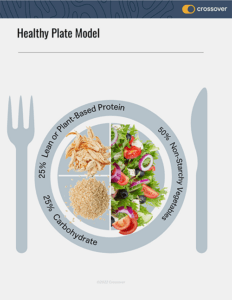 My Plate
My Plate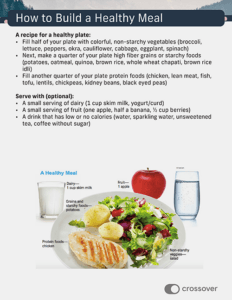 How to Build a Healthy Meal
How to Build a Healthy Meal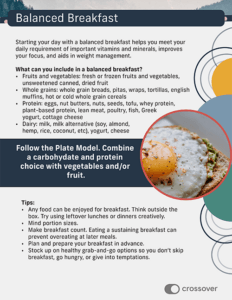 Balanced Breakfast
Balanced Breakfast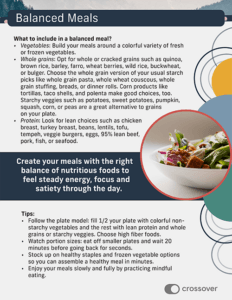 Balanced Lunch and Dinner
Balanced Lunch and Dinner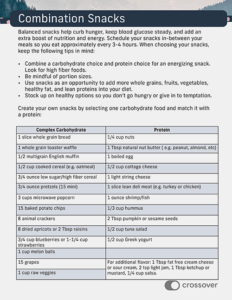 Combination Snacks
Combination Snacks Diet Review: Pros/Cons
Diet Review: Pros/Cons How to Track Your Food
How to Track Your Food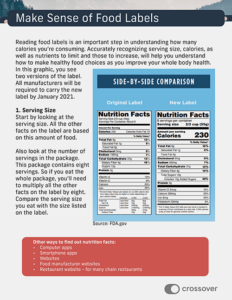 Make Sense of Food Labels
Make Sense of Food Labels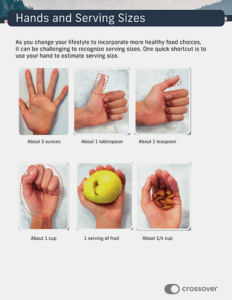 Hands and Serving Sizes
Hands and Serving Sizes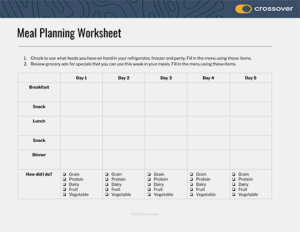 Meal Planning Template
Meal Planning Template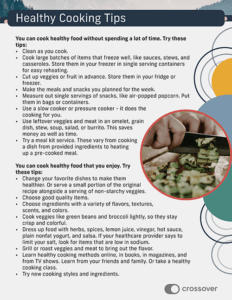 Healthy Cooking Tips
Healthy Cooking Tips Healthy Shopping Tips
Healthy Shopping Tips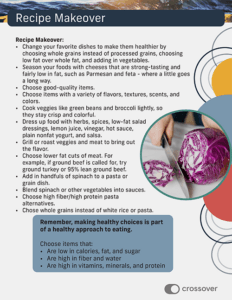 Recipe Makeover
Recipe Makeover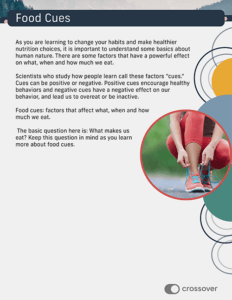 Food Cues
Food Cues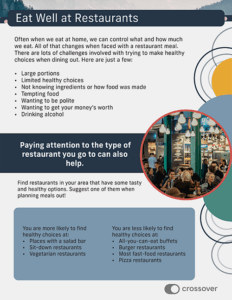 Eat Well At Restaurants
Eat Well At Restaurants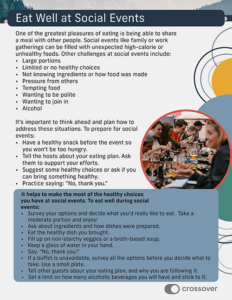 Eat Well At Social Events
Eat Well At Social Events Rethink Your Drink
Rethink Your Drink
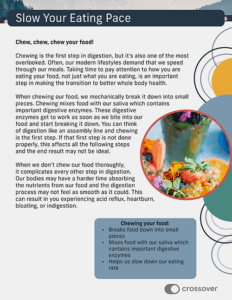 Slow Down Your Eating
Slow Down Your Eating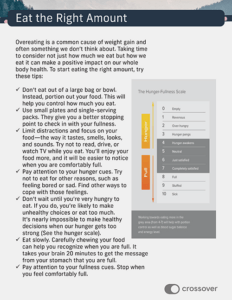 Savor Your Meal
Savor Your Meal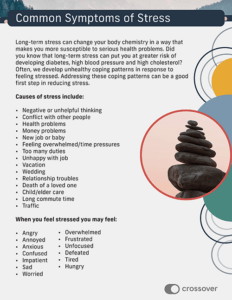 Causes of Stress
Causes of Stress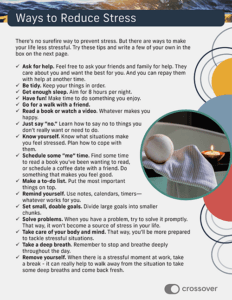 Ways to Reduce Stress
Ways to Reduce Stress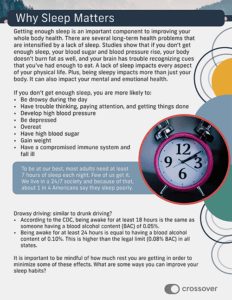 Why Sleep Matters
Why Sleep Matters Ways to Unwind
Ways to Unwind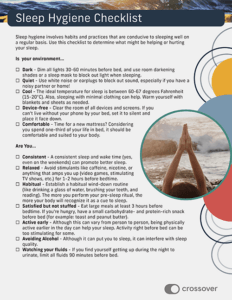 Sleep Hygiene Checklist
Sleep Hygiene Checklist Coping with Challenges – Getting Enough Sleep
Coping with Challenges – Getting Enough Sleep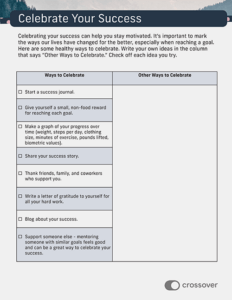 Celebrate Success
Celebrate Success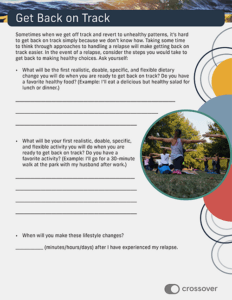 Get Back On Track
Get Back On Track